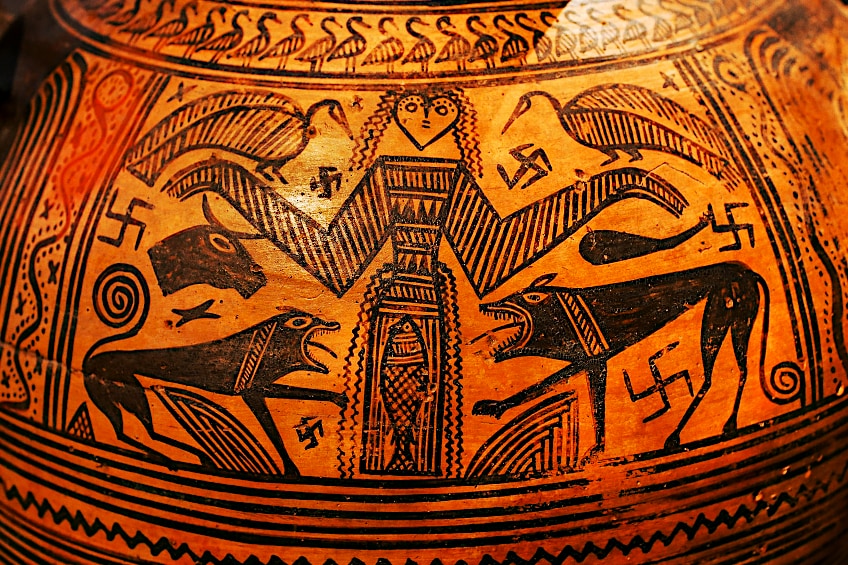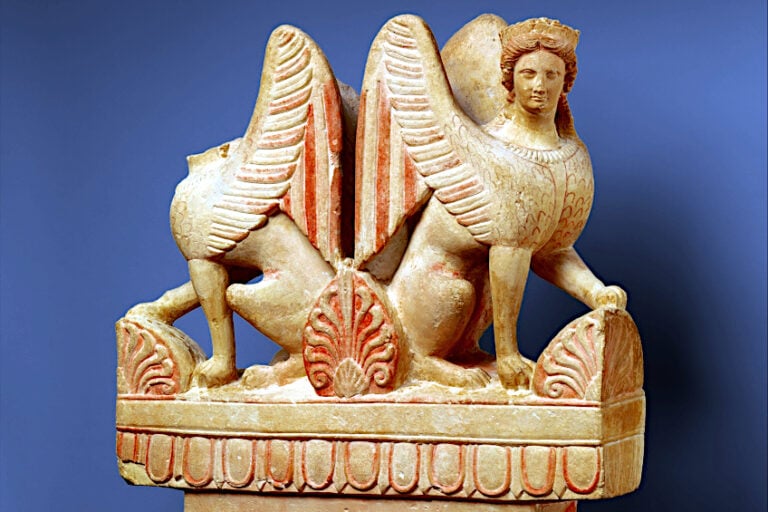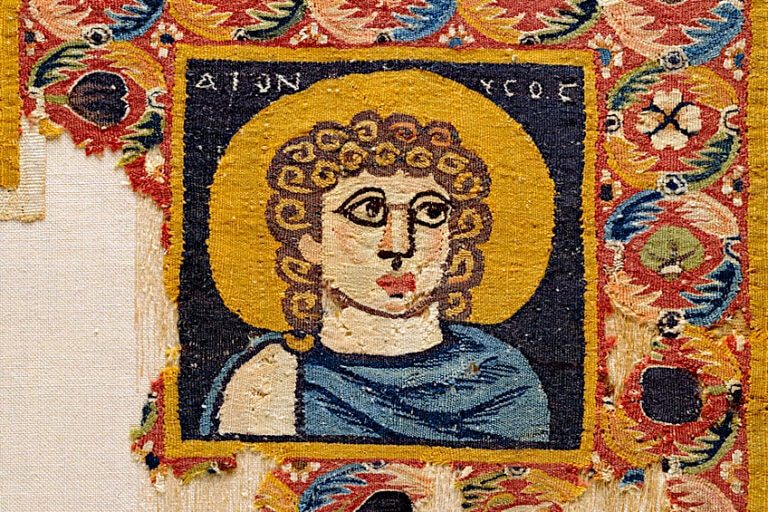Greek Goddess Artemis – Cruel Guardian of Untamed Things
What is Artemis’ personality like and what is Artemis the Goddess of? Known in the Greek pantheon as the goddess of hunting, the Greek goddess Artemis was also associated with wild animals, the wilderness, the protection of young boys, girls, and women in labor, and sudden death from illness or during childbirth. Below, we will explore the often paradoxical personality of Artemis as well as her symbols, attributes, family, and mythology.
The Mythology of the Greek Goddess Artemis
| Name | Artemis |
| Gender | Female |
| Symbols | Bows and arrows, torch, and crescent moon |
| Personality | Fierce, defensive, destructive, vindictive |
| Domains | Hunting, animals, wilderness, the young, childbirth |
| Parents | Zeus and Leto or Persephone; Dionysus and Isis (in later Hellenistic myth) |
| Spouse | Unmarried |
Possibly one of the most complicated of the ancient Greek divinities, the name Artemis was used to designate at least three distinct cult figures. These included the Brauronian Artemis, Arcadian Artemis, and Ephesian Artemis. In later cult, Artemis was often identified with the moon goddess Selene and Hecate queen of witches.
Artemis appears to have evolved from several ancient Mediterranean and Near Eastern deities, and some of the rituals absorbed into her worship were even said to include human sacrifice
Her sacred precincts were mainly located in mountainous and wild areas, reflecting her role as the goddess of hunting. One main exception being the grand temple of the Ephesian Artemis which was located near the city of Ephesus and ranked as one of the Seven Wonders of the ancient world. While the Ephesian Artemis was a mother goddess, throughout most of the Greek world Artemis was a virgin huntress who was mainly concerned with uncivilized creatures such as animals and young children.
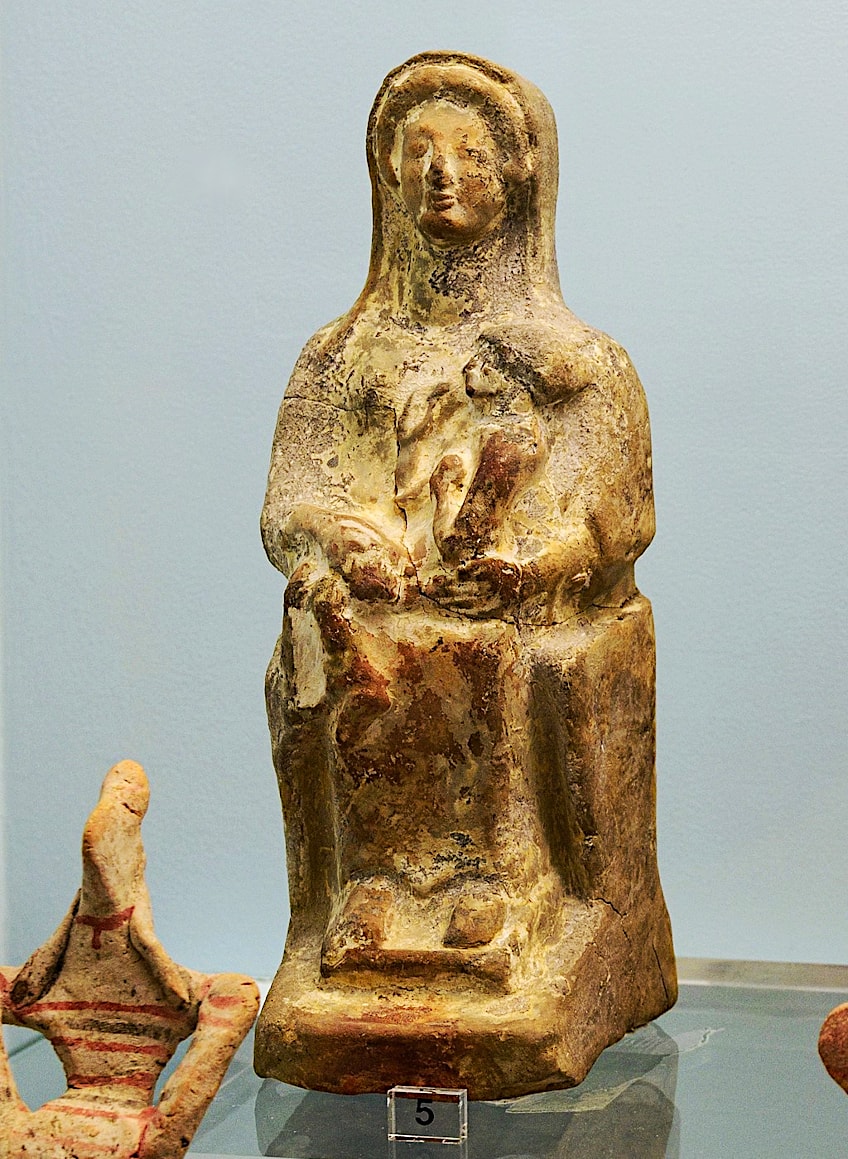 Votive figurine of Artemis Kourotrophos (child-rearing) (500-480 BCE); Zde, CC BY-SA 4.0, via Wikimedia Commons
Votive figurine of Artemis Kourotrophos (child-rearing) (500-480 BCE); Zde, CC BY-SA 4.0, via Wikimedia Commons
Artemis was also the goddess responsible for inflicting sudden death on women. As Artemis Locheia, she was goddess of childbirth and midwives, even though deaths during childbirth were attributed to her. Her temperament was highly volatile, ranging from kindness to cruelty, reflecting the untamed natural forces that lie beyond human society.
Background and Family
The untraceable etymology of the name Artemis, alongside possible references to her in Linear B inscriptions, has been taken to suggest that this goddess dates back to at least the Bronze Age, if not earlier.
In the Olympian pantheon the Greek goddess Artemis functioned as the polar opposite of her twin brother Apollo.
In the Homeric epics, Apollo was the god most concerned with moral conduct and upholding social norms. He was god of music, culture, and intellectual pursuits, while Artemis was named Potnia Theron (Mistress of the Beasts) and presided over untamed nature and guardian of children before they conform to their roles in adult society.
 Attic black-figure belly-amphora with a depiction of Artemis holding lions and flanked by youths (c. 550-530 BCE); ArchaiOptix, CC BY-SA 4.0, via Wikimedia Commons
Attic black-figure belly-amphora with a depiction of Artemis holding lions and flanked by youths (c. 550-530 BCE); ArchaiOptix, CC BY-SA 4.0, via Wikimedia Commons
The Birth of the Greek Goddess Artemis
Greek mythology is full of conflicting stories regarding the birth of Artemis and her twin brother, Apollo. However, all of these various accounts consider Zeus and the Titaness Leto to be the parents of the twins. In some stories her brother was born either earlier or later than Artemis, while in some accounts only Apollo’s birth is described. Hesiod and Homer both stated that Apollo and Artemis were the children of Zeus and Leto, but do not specify their birth order.
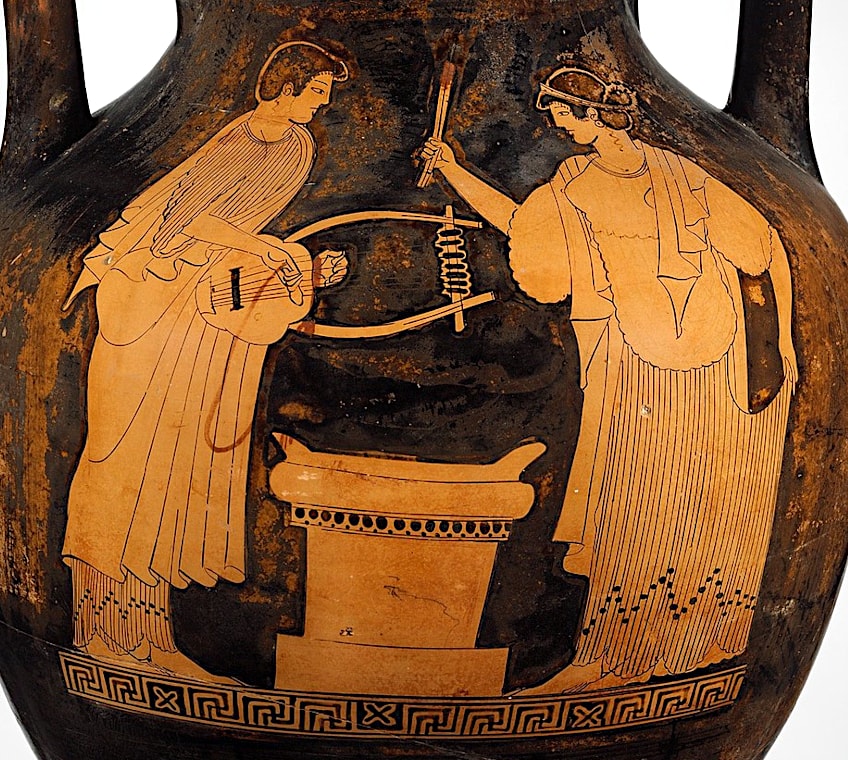 Attic red-figure amphora with a depiction of Apollo and Artemis flanking an altar (c. 490 BCE); Metropolitan Museum of Art, CC0, via Wikimedia Commons
Attic red-figure amphora with a depiction of Apollo and Artemis flanking an altar (c. 490 BCE); Metropolitan Museum of Art, CC0, via Wikimedia Commons
The father of Artemis and Apollo, Zeus, gained notoriety for his constant affairs with women other than his wife, Hera. The queen of the gods grew extremely vengeful, seeking to punish the women with whom Zeus had cheated. Upon discovering that Leto was pregnant with Zeus’ children, Hera cursed her so that she would not be able to give birth on any solid ground. Leto was forced to roam in search of a place to give birth to her children. Eventually found the free-floating island of Delos, which was not technically connected to the solid ground of the mainland.
According to one account of the story, Hera kidnapped the goddess of childbirth, Eileithyia, to prevent Leto from giving birth. This caused Leto considerable pain. Miraculously Artemis delivered herself and then assisted her mother in giving birth to Apollo.
It is due to this that she herself became regarded as a goddess of childbirth. However, seeing her mother in such great pain also caused Artemis to take a vow of celibacy, and swore to remain a virgin forever. This is why she was subsequently known as the protector of pregnant women, despite never having any children of her own. Leto carried the newborn twins to Lycia, where she tried to bathe the twins in a spring she had discovered there. However, the peasants who lived there prevented the babies and their mother from drinking the water by stirring the mud at the bottom of the spring. Leto was so enraged by the inhospitable Lycians that she changed them all into frogs, bound to live around the spring for the rest of their lives.
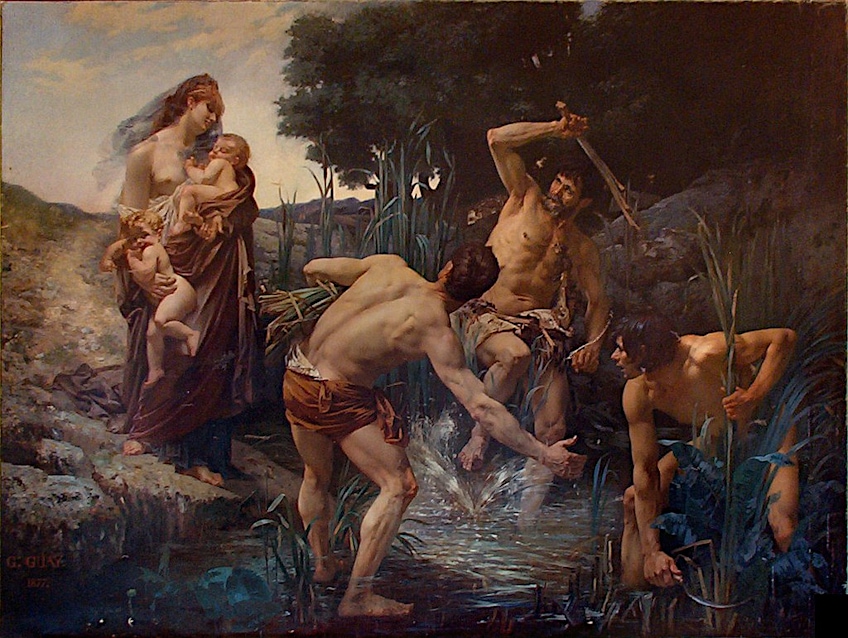 Leto and the Peasants by Gabriel Guay (1877); Gabriel Guay, Public domain, via Wikimedia Commons
Leto and the Peasants by Gabriel Guay (1877); Gabriel Guay, Public domain, via Wikimedia Commons
Artemis’ Role
Artemis, the Greek goddess of the wilderness, was revered throughout ancient Greece. Her most well-known cults were in Delos, Attica, and in Sparta. In artworks, she was often portrayed in a woodland setting, carrying her bow and arrows and escorted by a deer.
Before beginning a new military campaign, the ancient Spartans would offer sacrifices to her as one of their patron deities.
Prepubescent and teenage Athenian girls were taken to Artemis’ sanctuary at Brauron for a year of service to the goddess. They were known as “little she-bears” during that time. The origins of this initiation practice was mythologized as follows: The town of Brauron was frequented by a bear and the locals there would often feed it, thus the bear became tame over time. In some versions of the story, a girl tormented the bear, and it killed her, while in others, it clawed her eyes out. In any case, the girl’s siblings slaughtered the bear, and Artemis as Mistress of Beasts was furious. In order to atone for the bear’s murder, she insisted that teenage girls “act the bear” at her sanctuary.
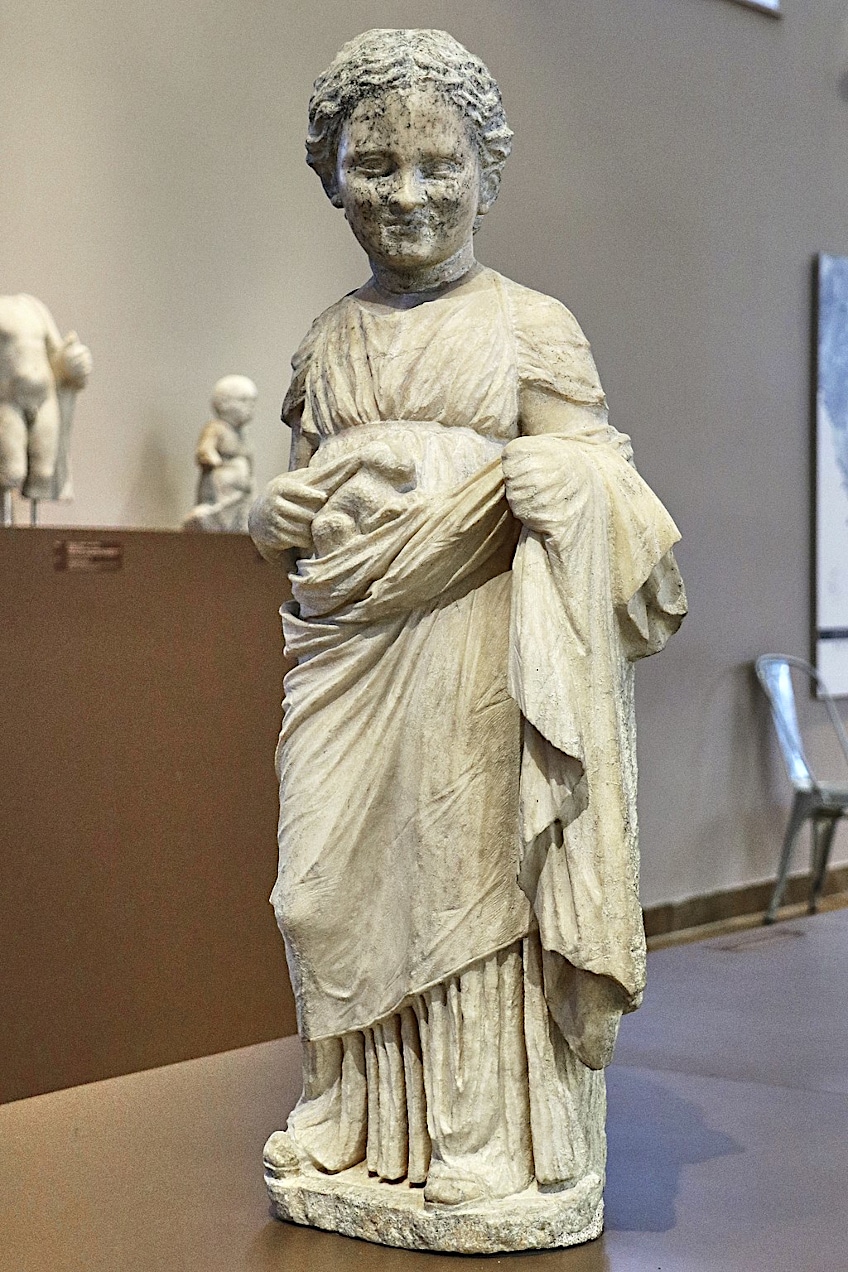 Statue of a young girl holding a hare from the sanctuary of Artemis at Brauron (c. 320 BCE); George E. Koronaios, CC BY-SA 4.0, via Wikimedia Commons
Statue of a young girl holding a hare from the sanctuary of Artemis at Brauron (c. 320 BCE); George E. Koronaios, CC BY-SA 4.0, via Wikimedia Commons
Artemis, along with Eileithyia, was revered as goddess of midwifery. Clothing dedications to her sanctuary upon a successful delivery were prevalent in the Classical period. As the goddess responsible for childbirth, but also associated with death during labor, Artemis was both called on and feared by pregnant women. Artemis, as with Apollo, was also associated with dance and music and she is portrayed dancing and singing along with her entourage of nymphs.
However when it comes to music, Artemis is more closely aligned with the orgiastic rites of gods such as Dionysus than the harmonious and civilizing effects of music ascribed to Apollo.
Artemis’ Personality, Attributes, and Symbols
Artemis enjoyed enormous influence over humanity and earthly events. Artemis possessed impeccable aim with her bow and arrows with which she brought sudden death to women. She had the power to transform herself and other people into animals as well as control over diseases and healing.
Artemis was eternally youthful and like her half-sister Athena was fiercely defensive of her virginity.
She was known to dislike any sort of romantic union or marriage as these meant the loss of personal autonomy for women. She was could be deeply vindictive, particularly when it came to men, while being deeply protective of children and unmarried young women.
Physical Appearance
The Greek goddess Artemis appears consistently as a youthful woman in her prime, healthy and quick on her feet. She dresses in a knee-length tunic, allowing her legs to move freely through the woods. Artemis is portrayed as fit, having spent most of her time hunting and exploring the woodlands and wilderness. She is said to be beautiful, yet nothing is known about the specific appearance she takes on. There are several representations of Artemis the Greek goddess of hunting, portrayed in the shooting stance, accompanied by a stag.
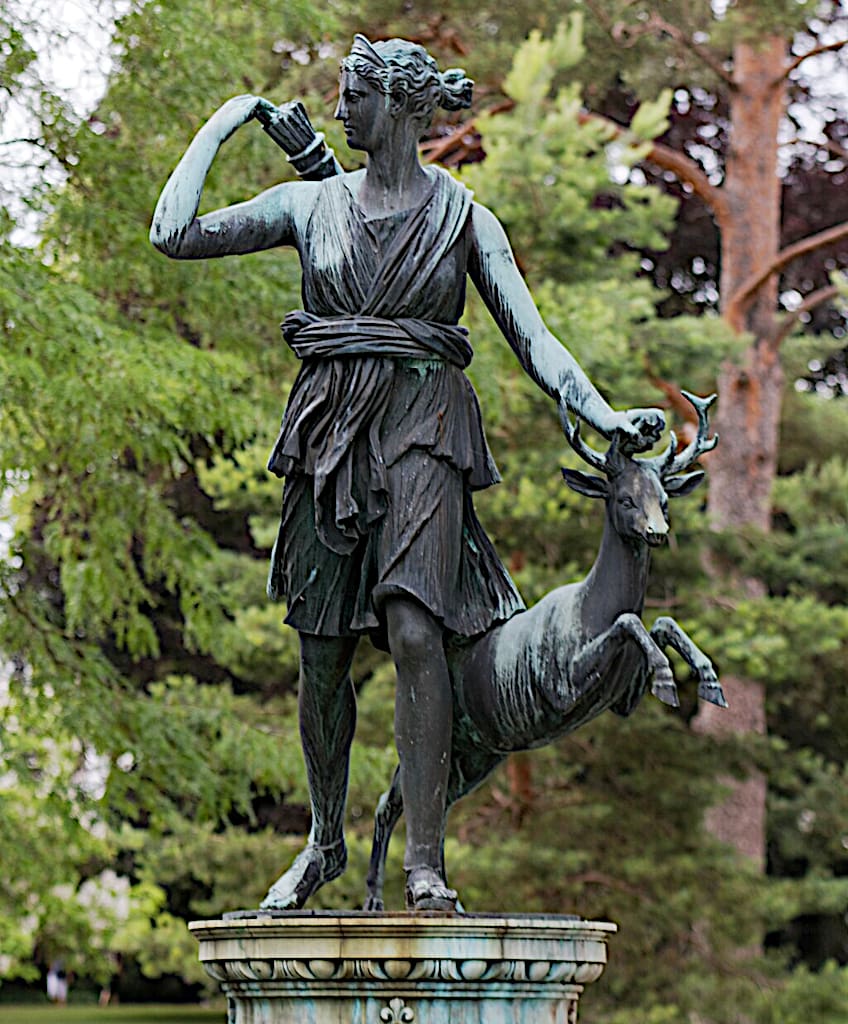 Partially restored and adapted Roman copy of a 4th Century BCE Greek statue of Artemis attributed to Leochares; Daniel VILLAFRUELA, CC BY-SA 4.0, via Wikimedia Commons
Partially restored and adapted Roman copy of a 4th Century BCE Greek statue of Artemis attributed to Leochares; Daniel VILLAFRUELA, CC BY-SA 4.0, via Wikimedia Commons
When depicted in association with lunar divinities such as Selene and Hecate, Artemis wore a long robe, and occasionally her head was covered by a veil. In some vase paintings, Artemis is depicted as the death-bringing deity whose arrows brought death to women, such as Niobe’s daughters.
 Boeotian early Orientalizing neck-amphora with a depiction of Artemis as Potnia Theron (Mistress of the Beasts) (c. 680-670 BCE); ArchaiOptix, CC BY-SA 4.0, via Wikimedia Commons
Boeotian early Orientalizing neck-amphora with a depiction of Artemis as Potnia Theron (Mistress of the Beasts) (c. 680-670 BCE); ArchaiOptix, CC BY-SA 4.0, via Wikimedia Commons
Early depictions of Artemis emphasize her function as the Mistress of Beasts, appearing winged and holding a bird or animals in each of her hands. On the handles of the famed Francois Vase, for instance, she grasps a stag and panther in one rendition and lions in others. She is often carrying a torch on later Attic red and black figure vases.
In later art, Artemis was often depicted with a crescent moon, an iconographic attribute reflecting her later association with Diana, the Italo-Roman goddess of the hunt and the moon.
Depictions of the Artemis of Ephesus differ significantly from those associated with the virgin huntress. As a mother goddess, the Ephesian Artemis was associated with fertility. The cult statue in her great temple consisted of a column-like figure covered from the neck down in what scholars have speculated are either multiple layers of breasts or the testicles of sacrificed bulls.
 Ephesian Artemis (125-175 CE); Carole Raddato from FRANKFURT, Germany, CC BY-SA 2.0, via Wikimedia Commons
Ephesian Artemis (125-175 CE); Carole Raddato from FRANKFURT, Germany, CC BY-SA 2.0, via Wikimedia Commons
Attributes
Artemis as a virgin goddess is probably tied to her main function as a huntress. Hunters historically refrained from sex before hunting as an act of ceremonial purity and because they believed that the scent would drive away prospective game. Within the ancient cultural framework, marriage for girls occurred at a much younger age than for boys.
A girl entered adulthood, and with it the rigid structures of civilized behavior upon marriage, while a boy would enter adulthood a few years before he could expect to be married. In this sense, Artemis’ virginity is a mark of her association with the freedom of youth and the untamed wilderness that persisted beyond human society.
It is a trait that distinguishes Artemis as her own ruler, as opposed to a kind of asexuality. Her virginity could represent an abundance of fertility that may be distributed among those who worship her, similar to earlier mother-goddess deities. Artemis was sometimes conflated with indigenous mother-goddess deities in Asia Minor, such as Anahita in Iran and Cybele. Several subsequent Greek writers, however, came to regard Artemis as intrinsically asexual and as the polar opposite of the goddess of love herself, Aphrodite.
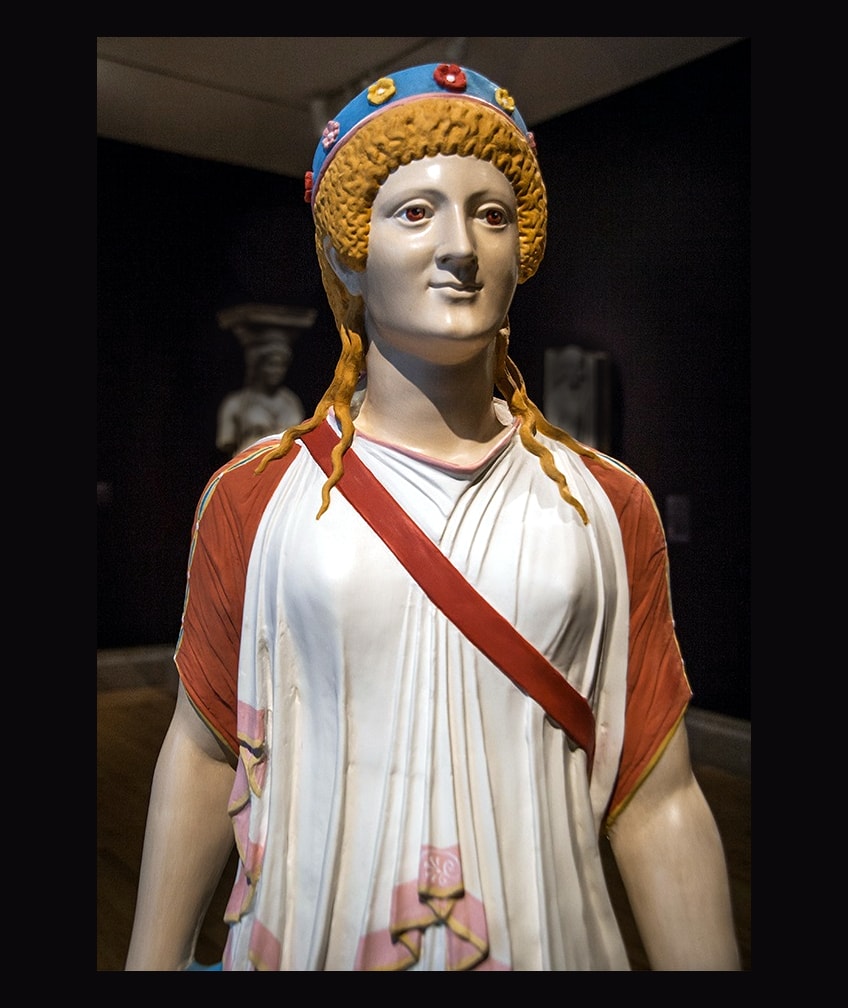 Modern cast-marble copy of a Roman copy of a 6th Century BCE Greek statue of Artemis with reconstructed polychromy; Alaskanspaceship, CC BY-SA 4.0, via Wikimedia Commons
Modern cast-marble copy of a Roman copy of a 6th Century BCE Greek statue of Artemis with reconstructed polychromy; Alaskanspaceship, CC BY-SA 4.0, via Wikimedia Commons
No documentation exists of the Greeks ever referring to the Greek goddess Artemis as a moon deity because their lunar goddess was Selene. However, the Romans connected Artemis with Selene, resulting in them seeing her as a moon goddess.
As the Romans came to equate Apollo with Helios, the embodiment of the Sun, it seemed only natural for them to start associating Artemis, twin sister of Apollo, with Selene, Helios’ own sister and the embodiment of the Moon.
Over time, Artemis’ association with pregnancy and childbirth inevitably led to her being identified with the menstrual cycle, and hence the Moon.
Artemis’ Symbols
The Greek goddess Artemis was said to be armed with a golden bow and arrows. Artemis’ arrows were able to cause unexpected death and sickness in both younger girls and women. Artemis received her first bow and arrow from the Cyclopes, as she had requested from her father.
Artemis’ chariot was gold, and it was drawn by four deer with golden horns. Her chariot’s bridles were similarly fashioned of gold.
Artemis occasionally appears with a hunting spear, however, such depictions are largely confined to the region of Aetolia. Ovid’s Metamorphoses has a description of Artemis’ spear and is associated with her worship as a Greek goddess of fishing. Artemis is also often depicted with a lyre since she is the goddess of the songs and dances of the maidens. Artemis saw the deer as her sole sacred animal.
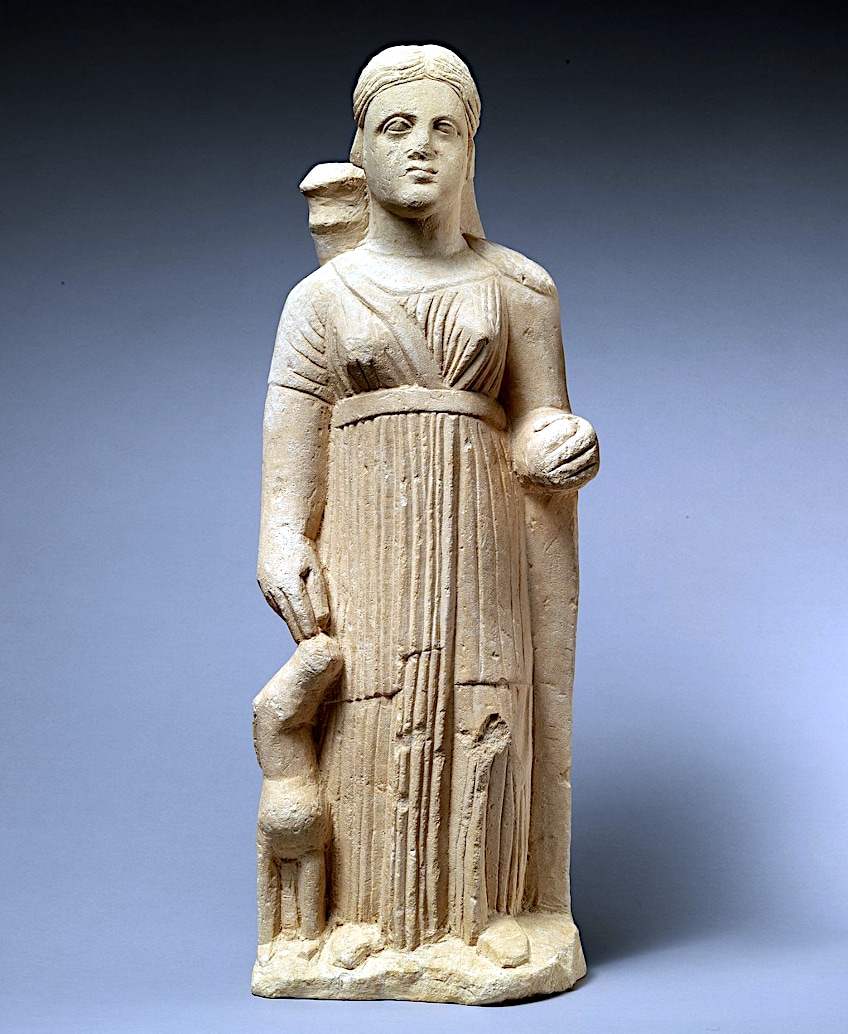 Cypriot limestone statuette of Artemis (3rd Century BCE); Metropolitan Museum of Art, CC0, via Wikimedia Commons
Cypriot limestone statuette of Artemis (3rd Century BCE); Metropolitan Museum of Art, CC0, via Wikimedia Commons
She fell deeply in love with these animals after noticing a deer bigger than a bull with glistening horns. Deer were also among the first creatures she ever caught. Eurystheus commanded Heracles’ third labor, which was to capture the Cerynitian Hind alive. Heracles sought Artemis’ mercy and vowed to bring it back alive. Artemis pardoned him but saved her anger for Eurystheus.
Pan gave Artemis her hunting hounds in Arcadia’s woodland. He gave the goddess of hunting two black and white hounds, three red-colored ones, and one speckled one capable of hunting lions.
Pan also gifted Artemis several of the Arcadian race’s finest female breeding dogs, but Artemis could only take seven hounds hunting at a time. The Brauron cult initiated the practice of sacrificing a bear to the Greek goddess of hunting. Hunters would also sacrifice a boar in her honor, as they were regarded as the most difficult animals to tame.
Artemis’ Worship and Domain of Influence
Artemis had important sanctuaries at Tauris, Brauron, Perge, Magnesia, as well as on the island of Delos. In addition, many significant festivals were associated with this goddess. At the Festival of Artemis in Brauron, little girls aged between five and ten appeared in saffron robes and pretended to be bears to appease Artemis after her animal was murdered and she released the plague. The Festival of Artemis Saronia is a celebration of Artemis at Trozeinos, Argolis. After the goddess saved his life while he went hunting and was swept away by a wave, a monarch named Saron constructed a sanctuary for her. He then organized a festival in her honor.
 Votive relief from Brauron depicting Artemis receiving worshipers (350 BCE); Archaeological Museum of Brauron, Public domain, via Wikimedia Commons
Votive relief from Brauron depicting Artemis receiving worshipers (350 BCE); Archaeological Museum of Brauron, Public domain, via Wikimedia Commons
Another place in Attica was utilized to carry out holy ceremonies for young girls and women preparing to marry at Brauron. The location functioned as the goddess’s shrine where anyone interested in her mythology could rejoice and study. While Artemis preferred females and women, young boys were also often depicted visiting the place to present offerings to the goddess. There is very little remaining evidence of the pre-marital ceremonies that may have taken place there. However, some pottery has been discovered, depicting young females leaping and performing ecstatic dances.
At the altar of Artemis Orthia in Sparta young Spartan boys enduring a ritual scourging as sacrifice to her. Scholars have suggested that this rite derived from earlier human sacrifices to the Taurian Artemis.
Artemis Ephesia was notably worshiped in Ephesus as a mother goddess, which was close to Ortygia, which many accounts claimed was her actual birthplace and not the island of Delos. Her worship in this region incorporated eastern features drawn from deities like Cybele and Isis, and her main symbols here were the date palm, bee, and stag. The city’s famed Artemis temple was nearly double the size of Athens’ Parthenon and took century to complete.
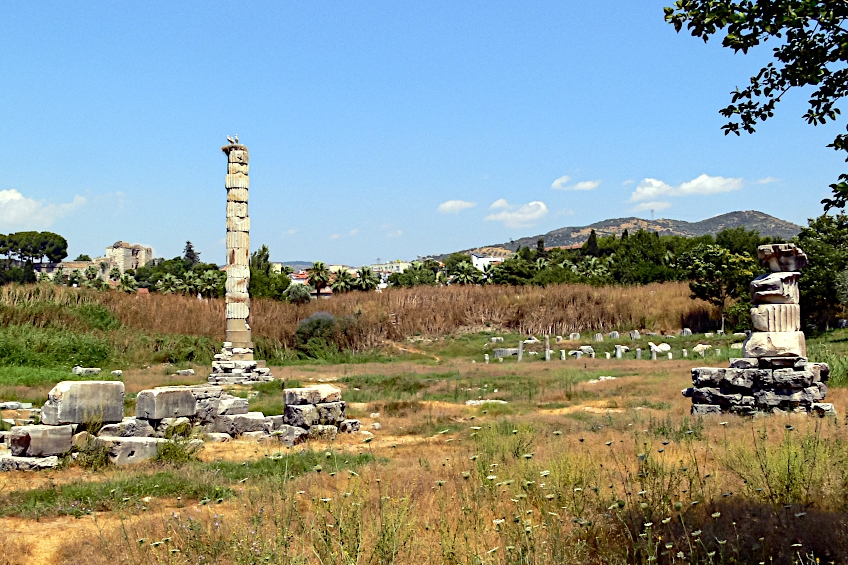 Remains of the Temple of the Ephesian Artemis in Modern day Turkey; stock photo
Remains of the Temple of the Ephesian Artemis in Modern day Turkey; stock photo
Artemis’ temple at Ephesus featured a total of 127 columns, and the architrave blocks atop these columns were so huge, (weighing around 24 tons apiece), that the Ephesians attributed its construction to the Greek goddess Artemis herself.
Inside the sanctuary was a massive cedar wood cult figure of the goddess. The temple’s foundations and a fairly sad single column made from composite materials are all that have survived to the present day.
The Mythology of Artemis
In literature and mythology Artemis appears as a dangerous and vindictive figure, but also as a goddess who could be helpful and kind. She was quick to punish any man who attempted to seduce her or overstepped his bounds. Artemis could also prove to be a useful ally. She healed Aeneas when he was wounded by Diomedes, warned the Telchines that Rhodes was about to suffer a destructive tidal wave, protected Orestes so that he could avenge Iphigeneia, and advised Hypermnestra to spare Lynceus when her 49 sisters obeyed their father’s orders to murder their husbands.
Even though Apollo was her twin, with the exception of stories that include Leto, Artemis rarely appears alongside him in myth.
By contrast, Leto’s twins were a popular subject in art. Artemis was also the patron deity of the mythical tribe of female warriors known as the Amazons, who also served as her priestesses. According to Callimachus, Artemis received her bow and arrows from the Cyclopes on the isle of Lipari who produced the weapons of the gods in the forge of Hephaestus.
Artemis and the Giants
Artemis’ main attributes were considered to be her virginity and beauty, but she was also very intelligent. The Aloadae giants were rumored to be a pair of brothers. They were growing so big and strong that even the gods feared them. Artemis realized that the only people capable of killing these massive beings were the giants themselves.
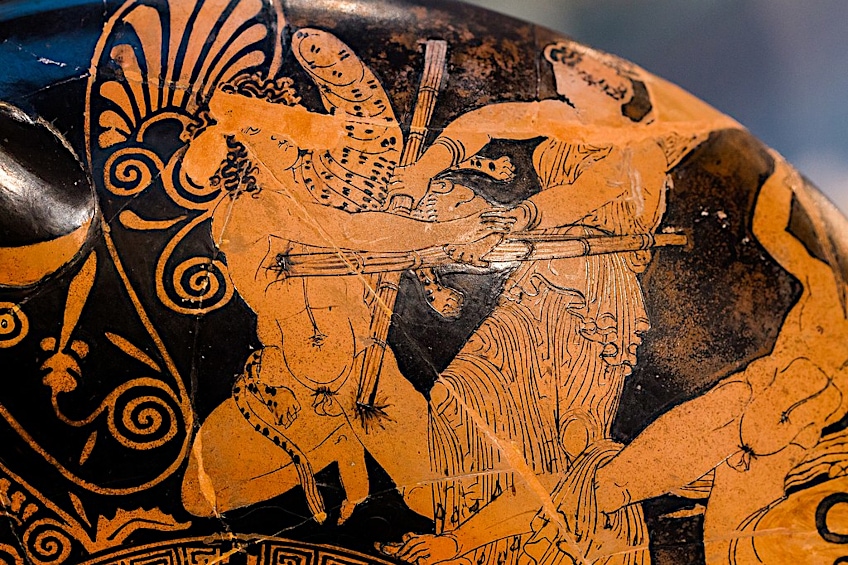 Detail from an attic red-figure cup showing Artemis attacking the Giant Gaion with two burning torches (c. 410-405 BCE); ArchaiOptix, CC BY-SA 4.0, via Wikimedia Commons
Detail from an attic red-figure cup showing Artemis attacking the Giant Gaion with two burning torches (c. 410-405 BCE); ArchaiOptix, CC BY-SA 4.0, via Wikimedia Commons
No deity or man was powerful enough to confront them. Artemis walked to the woods where the two giants were out hunting. She transformed herself into a deer and rushed right between the two giants, encouraging them to throw their spears at her.
As the two brothers threw their spears, she moved out of the way, resulting in each brother being struck down by the spear thrown by the other.
Artemis and Actaeon
The myth regarding Actaeon consists of multiple versions, many of which are incomplete. The specifics vary, but they all revolve around the famous hunter Actaeon, whom Artemis transformed into a deer for his misconduct and who was then killed by hunting hounds. In most versions, the hounds were his, but they no longer recognized him and attacked him, while in some versions they are occasionally referred to as Artemis’ hounds.
Various versions differ in terms of Actaeon’s misconduct: sometimes the story involves the hunter seeing the virgin goddess unclothed, in some accounts hw boasted that he was a greater hunter than she was, or even that he was Zeus’ rival for Semele’s affections.
It is believed that the original story depicts Actaeon as the goddess’ hunting partner who, discovering her nude in her sacred spring, attempts to force himself on Artemis. As a result of this detestable behavior, he was subsequently transformed into a deer and eaten by his own hunting hounds.
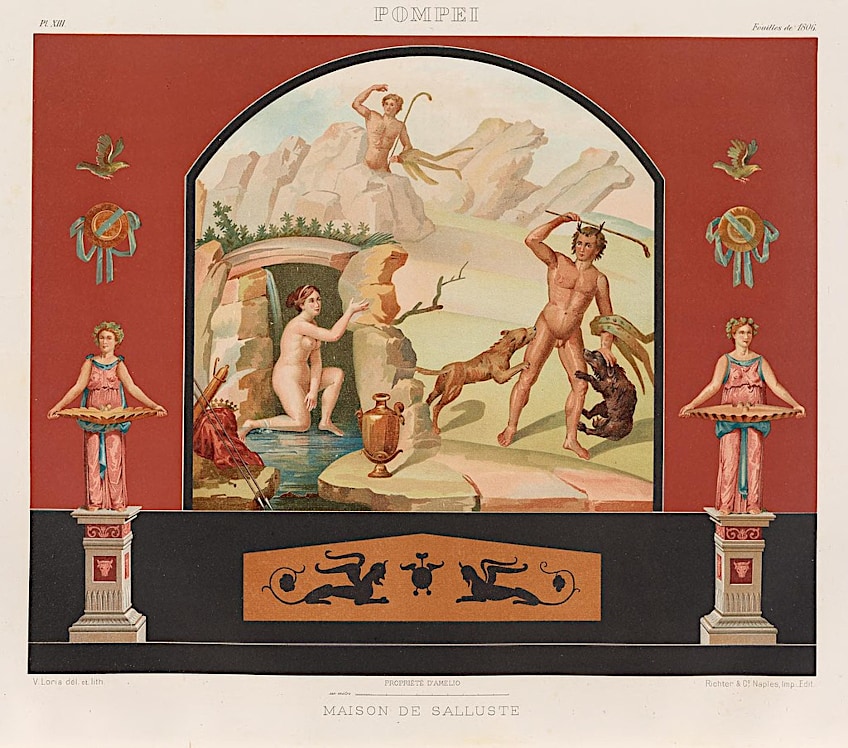 Lithographic copy of a fresco from Pompeii depicting the death of Actaeon (1890); Pasquale d’Amilio, Public domain, via Wikimedia Commons
Lithographic copy of a fresco from Pompeii depicting the death of Actaeon (1890); Pasquale d’Amilio, Public domain, via Wikimedia Commons
Artemis and Niobe
This myth is about Niobe, queen of Thebes, who declared blasphemously that she was superior to Artemis’ mother Leto. This myth is quite ancient; Homer was aware of it and asserted that Niobe had given birth to 12 offspring, six males and six daughters. According to some versions, there were 14 offspring.
Niobe claimed to be a greater mother than Leto since she had more children than Leto, which made Leto extremely angry.
She gathered her children and urged them to seek vengeance against Niobe. Artemis and Apollo descended on Thebes straight away. Apollo sneaked up on the sons as they were busy hunting out in the woods and killed all of them with his silver bow.
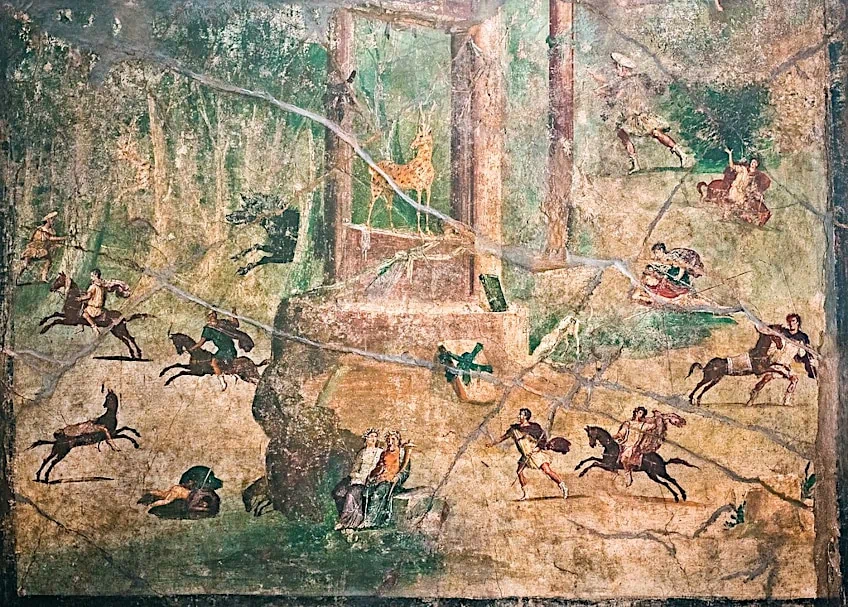 Fresco from Pompeii showing the death of the children of Niobe (20-10 BCE); ArchaiOptix, CC BY-SA 4.0, via Wikimedia Commons
Fresco from Pompeii showing the death of the children of Niobe (20-10 BCE); ArchaiOptix, CC BY-SA 4.0, via Wikimedia Commons
The bodies were taken to the palace. Niobe cried for them but refused to give up, arguing that she was still far superior to Leto since she still had seven daughters. Artemis then began shooting each of the girls one after the other. Artemis slayed the final one just as Niobe pleaded for her youngest daughter to be spared. Niobe wept bitter tears and was transformed into a rock. Amphion committed suicide after seeing his deceased sons. They were entombed by the gods themselves.
In other stories, Artemis and Apollo spared a single daughter and son because they begged Leto for protection; hence, Niobe was left with the same number of offspring as Leto, but no more.
Artemis and Orion
After failing to locate Oenopion, Orion met Artemis and Leto and accompanied the goddess in her hunting expeditions. He boasted about being an excellent hunter and killing every animal on the planet. Gaia was very displeased with this and summoned a massive scorpion to sting Orion. Artemis then transformed him into the constellation Orion. In one version of this myth, Orion ended up dying after moving Leto out of the way of the scorpion’s tail.
In a different version, Orion attempted to rape Opis, one of Artemis’ Hyperborean followers, so Artemis killed him.
In Aratus’ version, Orion tried to take Artemis’ robe, but she landed up killing him in self-defense. In a different version, Orion attempted to rape Opis, one of Artemis’ Hyperborean followers, so Artemis killed him. In Aratus’ version, Orion tried to take Artemis’ robe, but she landed up killing him in self-defense. Others have Artemis murder him for attempting to rape her or one of her maids.
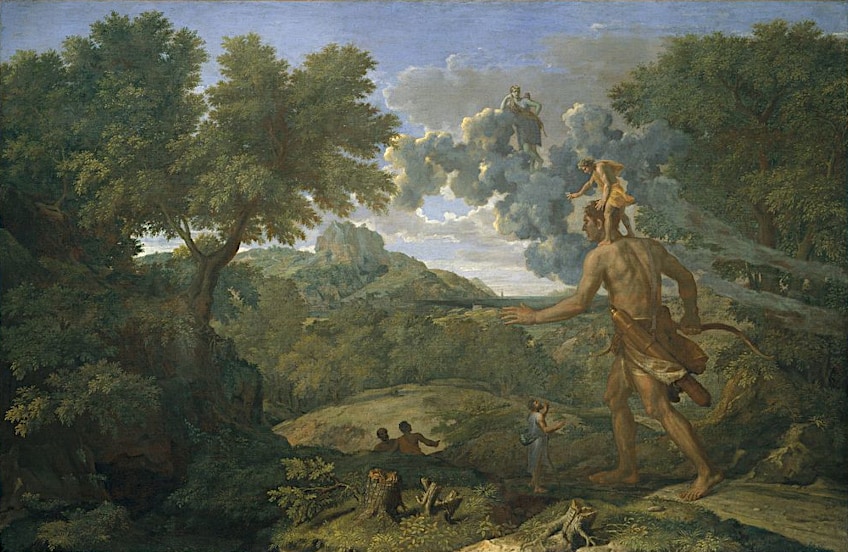 Blind Orion Searching for the Rising Sun by Nicolas Poussin (1658); Nicolas Poussin, Public domain, via Wikimedia Commons
Blind Orion Searching for the Rising Sun by Nicolas Poussin (1658); Nicolas Poussin, Public domain, via Wikimedia Commons
Estrus produced a version of the story in which the Greek goddess Artemis fell in love with Orion, which appears to be the only time Artemis ever fell in love with anybody. She wanted to marry Orion, and nothing Apollo said would be able to change her decision. While Orion was taking a dip in the water, Apollo decided to play a trick on Artemis, pointing at Orion and wagering that Artemis would not be able to hit that little “dot” on the horizon. Artemis, always keen to prove that she was the superior archer, shot and killed Orion.
Artemis placed the dead Orion amongst the stars, transforming him into the constellation known as the Hunter.
Artemis and Callisto
Callisto was one of Artemis’ hunting companions and swore to a vow of chastity as a companion of Artemis. Zeus then appeared to Callisto and managed to seduce her, causing her to fall pregnant. Though she was able to conceal her pregnancy for a period of time, she was found out while bathing. Enraged, Artemis changed Callisto into a bear, and Arcas was thus born.
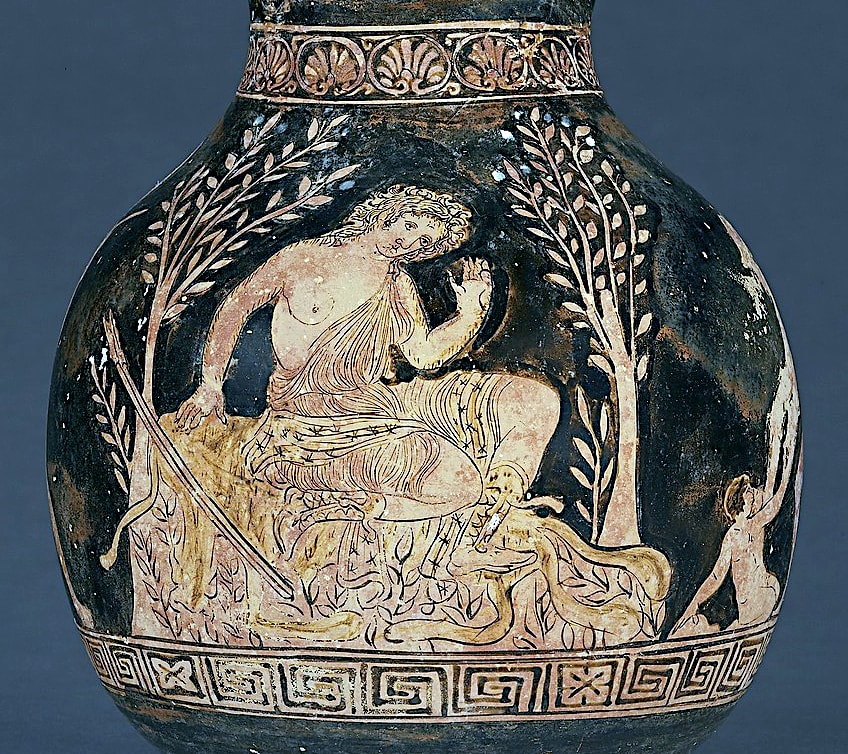 Apulian red-figure Chous with a depiction of Callisto turning into a bear (360 BCE); Unknown authorUnknown authorUnknown artistUnknown artist, Public domain, via Wikimedia Commons
Apulian red-figure Chous with a depiction of Callisto turning into a bear (360 BCE); Unknown authorUnknown authorUnknown artistUnknown artist, Public domain, via Wikimedia Commons
Callisto and the infant were taken by shepherds to Lycaon, but at some point she lost track of her child. When Callisto later entered a prohibited shrine of Zeus, she was pursued by an Arcadian mob which included her child, who did not know he was about to murder his mother.
Zeus intervened by transforming Callisto into the constellation of the Bear.
The Legacy of Artemis the Greek Goddess
Artemis is viewed as a symbol of independent and strong women. She is held up as an example of female courage, autonomy, and refusal to comply with narrow gender stereotypes. Artemis continues to encourage women in modern culture to embrace their autonomy. Many writers today are inspired by her fiery self-determination, affinity to nature, and personification of female strength. Artemis ruled over the woods and nature. As the Mistress of Beasts she is associated with animal conservation and wildlife preservation. The environmental aspect of her legacy is in line with present concerns about conservation and animal welfare.
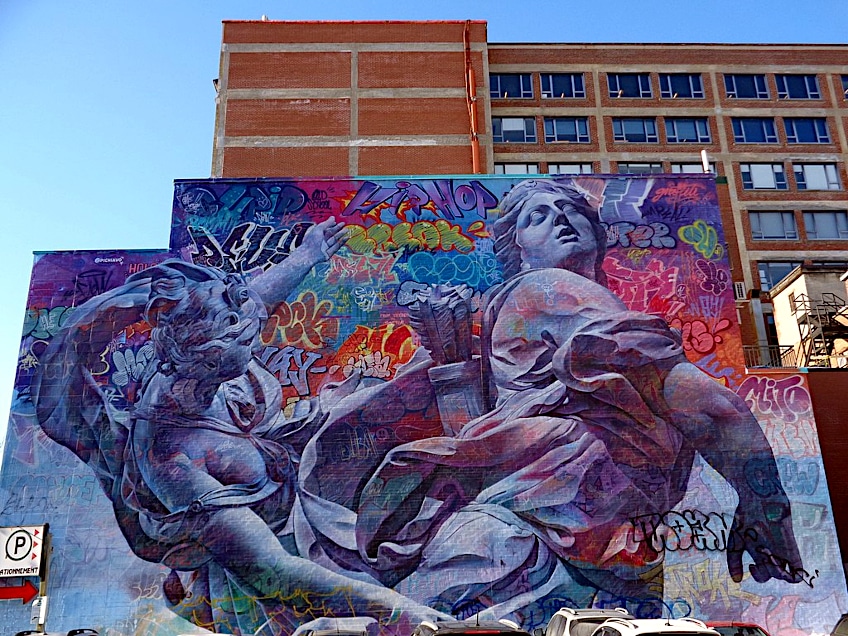 Diana/Artemis by PichiAvo (2019); art_inthecity from Montréal, CA, CC BY 2.0, via Wikimedia Commons
Diana/Artemis by PichiAvo (2019); art_inthecity from Montréal, CA, CC BY 2.0, via Wikimedia Commons
Artemis’ connection to the moon has resurfaced in the setting of space exploration. NASA’s Artemis program, whose name comes from the goddess, wants to send people back to the moon in the 2020s and establish a permanent presence there. The project aims to build on the Apollo missions’ legacy and prepare the path for deep space exploration in the near future. Artemis’ symbolism and image are still employed in a number of contexts, including product branding, logos, and popular culture. The Greek Goddess’ portrayal as a skillful archer and huntress is often associated with concentration, accuracy, and self-determination.
That completes our exploration of the Greek Goddess Artemis’ mythology. Artemis, the virgin goddess of hunting and the forest, was a popular Greek deity. Artemis was Zeus and Leto’s daughter. The ancients believed that from the moment she was born, she helped her mother deliver her brother, the Greek god Apollo, into the world. This mythological account elevated her to the status of the goddess of childbirth and midwifery. However, Artemis’ most popular portrayal was as a virgin goddess. Despite her role as a goddess associated with birth and children, she was not a fan of the idea of marriage, which in ancient Greece marked a young girl’s transition into adulthood and the rigid structures of civilized society.
Frequently Asked Questions
What Is Artemis the Goddess of in Ancient Greek Mythology?
The Greek goddess Artemis was a skillful huntress, and she was typically represented with her bow and arrow. She was in charge of wild creatures, the woods, and the natural world in general. Artemis was a virgin goddess who represented purity and independence. She refused to get married and focused on her own interests, preserving her autonomy and committing herself to her positions as a huntress and guardian of young women. Despite her vow of chastity, Artemis was also connected with childbirth. She was regularly summoned for aid during labor and was thought to be capable of alleviating birthing pain, although she could also cause death during childbirth. Artemis was Apollo’s twin sister, the Greek deity of music and healing. Both deities were depicted as archers and musicians.
What Was Artemis’ Personality Like?
As a guardian of women and children, she was known to have a strong personality and did not feel any empathy or mercy for those who wronged her or any woman. She was fiercely independent and refused to become romantically involved with anyone. She had a notoriously bad temper and her wrath was feared by many of the mortals and gods alike. Her arrows brought sudden death and illness to women, but she would also unexpectedly assist those in need.

I am deeply passionate about history and am constantly fascinated by the rich and complex stories of the past. As the editor-in-chief of learning-history.com, I have the opportunity to share this passion with a wide audience through the creation and distribution of engaging and informative content about historical events, persons, and cultures. Whether it’s through writing articles and blog posts or creating videos or podcasts, I strive to bring the past to life in a way that is both accurate and enjoyable. My expertise in history, combined with my strong writing and communication skills, allows me to effectively communicate complex historical concepts and make them accessible and interesting to a wide range of readers. I am truly grateful for the opportunity to share my love of history with others through my work on learning-history.com.

